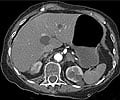A new research was presented at the CHEST 2007, the 73rd annual international scientific assembly of the American College of Chest Physicians (ACCP), where the use of the device Pulse cooximeter that quickly, inexpensively, and noninvasively identifies smokers was introduced. The device has long been used to identify and measure the levels of carbon monoxide (CO) in the blood of patients or firefighters. In this study, the researchers argue that if smokers know their blood CO levels, they may be more prone to quit or more likely to never start in the first place.
“By using this device in the office, the poisoning of the hemoglobin or blood with carbon monoxide can be detected and shown to the patient before they actually develop a clinical disease such as emphysema or cancer,” said study author Sridhar P. Reddy, MD, MPH, FCCP, St. Clair Pulmonary and Critical Care, St. Clair, MI. “In our practice, when the carboxyhemoglobin is 10%, it’s easy to tell a patient that 10% of his or her blood is poisoned and unable to carry oxygen. By doing this, we catch the patient’s attention right away and can begin smoking cessation counseling.”The study originated as a high school science project. Carried out by Dr. Reddy’s son. At each outpatient visit, Dr. Reddy measured patients’ carboxyhemoglobin, blood poisoned by CO, and methhemoglobin, blood transformed by other substances, such as nitrogen dioxide, with a pulse cooximeter. And, as part of his project, his son, who was a sophomore at Detroit Country Day School, developed and distributed questionnaires regarding the patients’ smoking status.
“When I was searching for a science project, I realized that the question of how much carboxyhemoglobin is needed to suggest smoking seemed unanswered,” said coauthor and son Ashray Reddy. “I thought that by trying to answer this question, I could help people quit smoking.”
Researchers used the pulse cooximeter, a device that is clipped to the patient’s finger and reads the percentages of poisoned blood through a light that is shined through the nail bed. A total of 476 patients who visited the clinic participated. Patients were identified as a smoker, based on a combination of their questionnaire responses and if they’re CO levels exceeded 6% of their blood. Researchers were also able to identify secondhand smokers based on slight changes found in their levels, as well. Results showed that 98 patients were smokers, 72 were secondhand smokers, and 306 were nonsmokers.
“For the first time, the entire smoking cessation story can be quickly and noninvasively played out from beginning to end—detection, revealing the effect, and intervention, all while being respectful of available resources,” said Dr. Reddy. “Using this device, we can deliver the whole package, and based on our data, we believe it should be routinely used in any program geared toward smoking cessation.”
Researchers conclude that pulse cooximetery is a quick, inexpensive, and noninvasive way to detect patients’ smoking status, and that the outpatient clinic is an ideal setting for its use. They also suggest its use for screening smoking status in multiple settings and populations, such as smoking cessation programs, high schools, hospitals, and the workplace.
Source-Eurekalert
GAN/C











